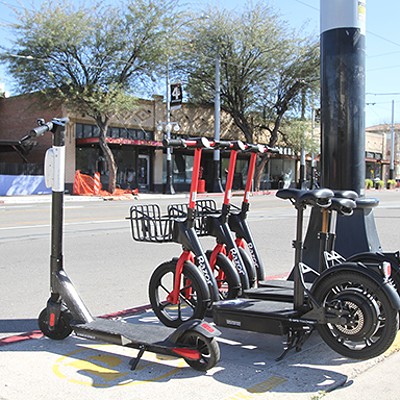But here's the bad news: City Transportation Director Jim Glock says that although plans to convert Stone and Sixth avenues into two-way streets will proceed as planned next summer, he thinks it's not going to be possible to transform Congress Street and Broadway Boulevard into two-way streets without creating serious traffic problems.
Although he hopes to get fresh information in the upcoming weeks, Glock says a study from last year looked at how changing Congress and Broadway to two-way roads would have a drastic effect on the multiple "intersection approaches" that each stoplight has. The analysis showed that in the area bounded by Speedway Boulevard, 22nd Street, Grande Avenue and Euclid Avenue, the number of failing intersection approaches--in other words, intersections with significant delays--at rush-hour jumped from three to 70.
"We're turning all the dials, because I've got a lot of pressure to make this thing work, but I don't see how I can at this point in time," Glock says. "But I'll know for sure, probably within the next two weeks."
Once the numbers from the final study are in, City Manager Mike Hein has asked Glock to present the findings to a City Council subcommittee meeting in January.
Downtown business advocates who want to see two-way streets are bristling at the notion that the City Council, which has approved the change from one-way streets, might be asked to reverse course.
"We're never going to change the character of the street and what it feels like from either a driving standpoint or a walking standpoint unless we go to two-way, because anything else that we do is not going to change the on-ramp-to-the-freeway mentality," says Donovan Durband, the executive director of the Tucson Downtown Alliance. "Most of this traffic is through traffic."
Richard Oseran, owner of Hotel Congress, says two-way streets are vital to building a business district along Congress Street. He says that although his hotel, restaurant and nightclub have been successful, the rest of Congress Street has struggled, thanks in part to one-way traffic.
"Our efforts have been to revitalize the central core and make downtown a great place," Oseran says. "A one-way street is not conducive to my perception of what Congress Street wants to be, what it once was and what it could be, and that's a place full of shops and cafes--a vibrant little urban community."
The city narrowed Congress Street to two lanes and added more than 140 on-street parking spaces last year, which reduced traffic by about 20 percent but also added to congestion in the area, Glock says.
Durband believes that changing the street to a two-way corridor, with one lane in each direction and a center turn lane, would dissuade pass-through drivers--who are just trying to reach Interstate 10 or drive further west--from using Congress Street. But he admits that it will lead to greater congestion on Congress Street.
"Sure, it will back up traffic more, and we acknowledge that it won't be able to happen until we build that last mile of Barraza-Aviation," Durband says.
Although a plan for that last mile is now in place, construction is still years off, according to Glock.
"I hope we can now roll up our sleeves and let the engineers and designers and architects get to work in putting together a set of construction drawings," says Glock, who adds that the latest modeling assumes that the final mile is in place. But the actual construction won't begin for another four or five years at the soonest, although work on a new Fourth Avenue underpass is expected to begin next summer.
Durband also suggests that pushing more traffic over to Broadway Boulevard would help improve the character of Congress Street.
"I don't mind if a lot of the through traffic continues on Broadway," Durband says. "I see Broadway as a very different street than Congress. Congress has that intimate scale with the historic buildings, and it's very narrow."

















